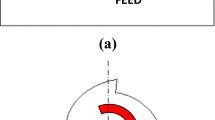Abstract
The paper investigates the effect of key cutting parameters of shoulder milling on the surface structure and fatigue properties of high strength aluminum alloy 7475-T7351. The very advanced milling whole carbide cutter and progressive milling process conditions have been analyzed in the respect of force loading, specific cutting energies, the volumetric surface parameters and fatigue life of thin-walled components used for the dynamically loaded primary aerospace structures. The evaluation of the surface structure of the machined samples prior the fatigue testing and morphologies of the fracture surfaces afterwards was done using the modern optical high-resolution 3D surface microscope ALICONA-IF G4 and Tescan Mira 3GM scanning electron microscope. Cyclic fatigue testing for three loading levels was performed using the axial BISS testing machine with an advanced control of the testing. The results confirmed a statistically significant influence of cutting conditions on the surface structure, however, the material inclusions dispersed in the adherent machined surfaces seems to be the most decisive factor affecting the material integrity that triggers the fatigue crack initiations and propagations. Some unique studies like tensile tests in situ in scanning electron microscopy have been also made.
Access this chapter
Tax calculation will be finalised at checkout
Purchases are for personal use only
Similar content being viewed by others
References
SUNDAY J. Ojolo. Machining Variables Influence on the Fatigue Life of End-Milled Alumina Alloy. International Journal of Materials Science and Applications. 2014, 3(6), 391. ISSN 2327-2635.
PANDIAN, P., PRABHU, R., SAKTHIMURUGAN, K. Surface error compensation in HSM of thin wall structures. International Journal of Engineering Science Invention. 2013. vol. 2, no. 2, pp. 1–11.
DENKENA, B., SCHMIDT, C. Experimental investigation and simulation of machining thin-walled workpieces. Production Engineering, Research and Development. 2007, Vol. 1, no. 4, pp. 343–350.
SHAHZAD, Majid. Influence de la rugosité et des traitements d’anodisation sur la tenue en fatigue des alliages d’aluminium aéronautiques 2214 et 7050. Toulouse, 2011. Thesis. L’Université de Toulouse. Supervisor M. Farhad Rézaï-Aria.
SASAHARA, Hiroyuki. The effect on fatigue life of residual stress and surface hardness resulting from different cutting conditions of 0.45%C steel. International Journal of Machine Tools and Manufacture. 2005, 45(2), 131–136. ISSN 08906955.
SURARATCHAÏ, Monchaï, Catherine MABRU a Rémy CHIERAGATTI. Influence de gammes d’usinage sur la tenue en fatigue d’un alliage léger aéronautique. In: 17ème Congrès Français de Mécanique. Toulouse, 2005.
GÓMEZ, A., SANZ, A., MARCOS, M. An Analysis of the Influence of Cutting Parameters on the Turning Process on the Fatigue Life of Aluminum Alloy UNS A92024-T351. Advanced Materials Research. 2012, 498, 19–24.
FOREJT, M., PÍŠKA, M. Teorie obrábění, tváření a nástroje (Theory of metal cutting and forming). Brno. Akademické nakladatelství CERM s.r.o., 2006. ISBN 80-214-2374-9.
M’SAOUBI, R., et al. A review of surface integrity in machining and its impact on functional performance and life of machined products. International Journal of Sustainable Manufacturing, 2008, Vol. 1, Nos. 1/2, pp. 208–236.
DAVIM, J.P. Surface Integrity in Machining. London: Springer London, 2010. ISBN 978-1-84882-873-5.
JIANG, X. Jane, WHITEHOUSE David J., Technological shifts in surface metrology. CIRP Annals - Manufacturing Technology. 2012, 61(2), 815–836. ISSN 00078506..
RÎPĂ, Minodora, TOMESCU HAPENCIUC, Lorena.. TRIBOLOGICAL CHARACTERISATION OF SURFACE TOPOGRAPHY USING ABBOTT-FIRESTONE CURVE. Romania: University “Dunărea de Jos” of Galati, România, 2003. ISSN 1221-4590.
ABBOTT, E.J., FIRESTONNE, F.A. (1933), Specifying surface quality, Mech. Eng., 55, 569–572.
NOVOVIC, D., R.C. DEWES, D.K. ASPINWALL, W. VOICE a P. BOWEN. The effect of machined topography and integrity on fatigue life. International Journal of Machine Tools and Manufacture. 2004, 44(2–3), 125-134. ISSN 08906955.
SIEBEL, E. a M. GAIER. Influence of surface roughness on the fatigue strength of steels and non-ferrous alloys. Engineers Digest. 18(1957), 109–112.
ZAHAVI, Eliahu, TORBILO Vladimir. Fatigue design: life expectancy of machine parts. Boca Raton: CRC Press, 1996. ISBN 08-493-8970-4.
HEARN, E. J. Mechanics of materials: an introduction to the mechanics of elastic and plastic deformation of solids and structural materials. 3rd ed. Boston: Butterworth-Heinemann, 1997. ISBN 978-0-7506-3266-9.
THONAS, Watkins. Measurement and Analysis of Residual stress in ε-phase Iron Niitride Layers as a function of Depth. International Centre for Diffraction Data. 2000, 2(43), 31–38.
MANKAR, D. S. a P. M. KHODAKE. Residual stress produced after machining in mechanical components and its effects on fatigue life: A state of art International Journal of Mechanical and Production Engineering Research and Development (IJMPERD). 2015, 5(1), 1–10. ISSN 2249-6890.
ALLOY 7475 PLATE AND SHEET. Iowa: ALCOA. [cit. 2016-08-20]. Available from: https://www.arconic.com/mill_products/catalog/pdf/alloy7475techplatesheet.pdf.
G.A. WEBSTER, R.C. WIMPORY, Non-destructive measurement of residual stress by neutron diffraction, Journal of Materials Processing Technology, Volume 117, Issue 3, 2001, Pages 395–399, ISSN 0924-0136, http://dx.doi.org/10.1016/S0924-0136(01)00802-0.
HK4 strain scanner. Nuclear Physics Institute ASCR [online]. Available from: http://neutron.ujf.cas.cz/en/hk4/item/144-hk4-description.
HUTCHINGS, M.T., WITHERS, P.J., HOLDEN, T.M., LORENTZEN T., Boca Raton, FL: Taylor & Francis, 2005, p. 420. ISBN: 9780415310000.
Acknowledgements
This research work was supported by the Brno University of Technology, Faculty of Mechanical Engineering, Specific research 2016, with the grant “Research of modern production technologies for specific applications”, FSI-S-16-3717, and by the project CEITEC 2020, LQ1601, Ministry of Education, Youth and Sports of the Czech Republic, and the residual stress analysis was done in cooperation with CANAM infrastructure of Nuclear Physics Institute, Řež near Prague, Czech Republic, and was supported through MŠMT infrastructural projects LM2015056 and LM2015074.
Author information
Authors and Affiliations
Corresponding author
Editor information
Editors and Affiliations
Rights and permissions
Copyright information
© 2018 Springer International Publishing AG
About this paper
Cite this paper
Piska, M., Ohnistova, P., Hornikova, J., Hervoches, C. (2018). A Study of Progressive Milling Technology on Surface Topography and Fatigue Properties of the High Strength Aluminum Alloy 7475-T7351. In: Ambriz, R., Jaramillo, D., Plascencia, G., Nait Abdelaziz, M. (eds) Proceedings of the 17th International Conference on New Trends in Fatigue and Fracture. NT2F 2017. Springer, Cham. https://doi.org/10.1007/978-3-319-70365-7_2
Download citation
DOI: https://doi.org/10.1007/978-3-319-70365-7_2
Published:
Publisher Name: Springer, Cham
Print ISBN: 978-3-319-70364-0
Online ISBN: 978-3-319-70365-7
eBook Packages: Chemistry and Materials ScienceChemistry and Material Science (R0)




